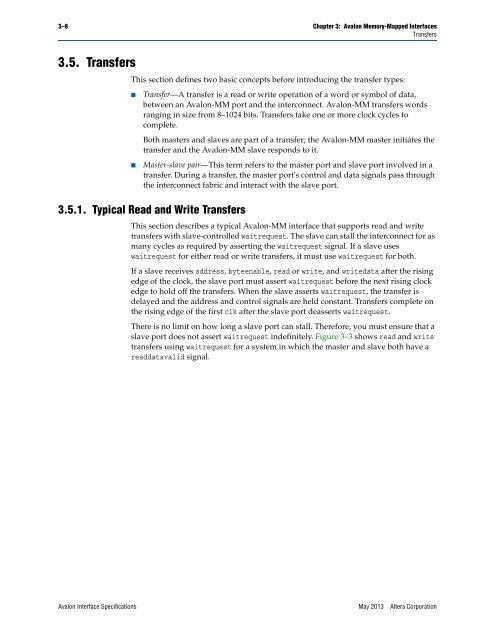Avalon Interface Specifications (PDF) - Altera
Avalon Interface Specifications (PDF) - Altera
Avalon Interface Specifications (PDF) - Altera
You also want an ePaper? Increase the reach of your titles
YUMPU automatically turns print PDFs into web optimized ePapers that Google loves.
3–8 Chapter 3: <strong>Avalon</strong> Memory-Mapped <strong>Interface</strong>s<br />
Transfers<br />
3.5. Transfers<br />
This section defines two basic concepts before introducing the transfer types:<br />
■ Transfer—A transfer is a read or write operation of a word or symbol of data,<br />
between an <strong>Avalon</strong>-MM port and the interconnect. <strong>Avalon</strong>-MM transfers words<br />
ranging in size from 8–1024 bits. Transfers take one or more clock cycles to<br />
complete.<br />
Both masters and slaves are part of a transfer; the <strong>Avalon</strong>-MM master initiates the<br />
transfer and the <strong>Avalon</strong>-MM slave responds to it.<br />
■ Master-slave pair—This term refers to the master port and slave port involved in a<br />
transfer. During a transfer, the master port's control and data signals pass through<br />
the interconnect fabric and interact with the slave port.<br />
3.5.1. Typical Read and Write Transfers<br />
This section describes a typical <strong>Avalon</strong>-MM interface that supports read and write<br />
transfers with slave-controlled waitrequest. The slave can stall the interconnect for as<br />
many cycles as required by asserting the waitrequest signal. If a slave uses<br />
waitrequest for either read or write transfers, it must use waitrequest for both.<br />
If a slave receives address, byteenable, read or write, and writedata after the rising<br />
edge of the clock, the slave port must assert waitrequest before the next rising clock<br />
edge to hold off the transfers. When the slave asserts waitrequest, the transfer is<br />
delayed and the address and control signals are held constant. Transfers complete on<br />
the rising edge of the first clk after the slave port deasserts waitrequest.<br />
There is no limit on how long a slave port can stall. Therefore, you must ensure that a<br />
slave port does not assert waitrequest indefinitely. Figure 3–3 shows read and write<br />
transfers using waitrequest for a system in which the master and slave both have a<br />
readdatavalid signal.<br />
<strong>Avalon</strong> <strong>Interface</strong> <strong>Specifications</strong> May 2013 <strong>Altera</strong> Corporation
















